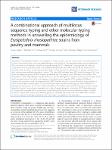A combinational approach of multilocus sequence typing and other molecular typing methods in unravelling the epidemiology of Erysipelothrix rhusiopathiae strains from poultry and mammals
Janßen, Traute
Voss, Matthias
Kühl, Michael
Semmler, Torsten
Philipp, Hans-Christian
Ewers, Christa
Erysipelothrix rhusiopathiae infections re-emerged as a matter of great concern particularly in the poultry industry. In contrast to porcine isolates, molecular epidemiological traits of avian E. rhusiopathiae isolates are less well known. Thus, we aimed to (i) develop a multilocus sequence typing (MLST) scheme for E. rhusiopathiae, (ii) study the congruence of strain grouping based on pulsed-field gel electrophoresis (PFGE) and MLST, (iii) determine the diversity of the dominant immunogenic protein SpaA, and (iv) examine the distribution of genes putatively linked with virulence among field isolates from poultry (120), swine (24) and other hosts (21), including humans (3). Using seven housekeeping genes for MLST analysis we determined 72 sequence types (STs) among 165 isolates. This indicated an overall high diversity, though 34.5% of all isolates belonged to a single predominant ST-complex, STC9, which grouped strains from birds and mammals, including humans, together. PFGE revealed 58 different clusters and congruence with the sequence-based MLST-method was not common. Based on polymorphisms in the N-terminal hyper-variable region of SpaA the isolates were classified into five groups, which followed the phylogenetic background of the strains. More than 90% of the isolates harboured all 16 putative virulence genes tested and only intI, encoding an internalin-like protein, showed infrequent distribution. MLST data determined E. rhusiopathiae as weakly clonal species with limited host specificity. A common evolutionary origin of isolates as well as shared SpaA variants and virulence genotypes obtained from avian and mammalian hosts indicates common reservoirs, pathogenic pathways and immunogenic properties of the pathogen.
No license information

